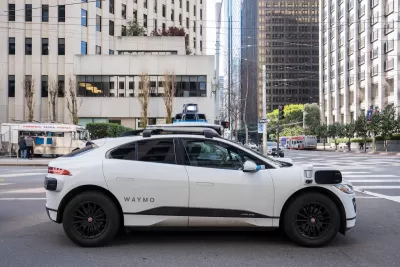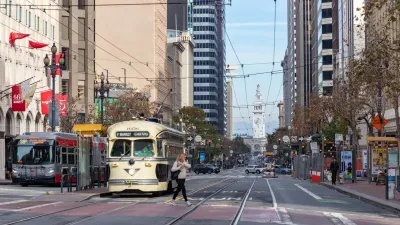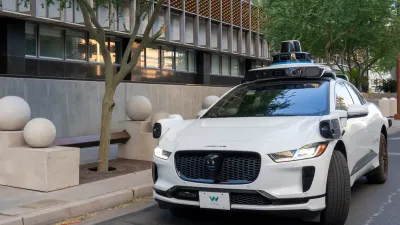Recent efforts to paint autonomous ride-hailing services as a complement to public transit are, according to CityLab’s David Zipper, greenwashing.

Is autonomous ride-hailing “an asset to cities and transit agencies?” In a piece for Bloomberg CityLab, David Zipper questions this assertion, which robotaxi companies are eager to make. “Transit-robotaxi synergy is an enticing message at a time when public transportation agencies face a dire funding shortage, and it could especially resonate among left-leaning residents in places like the Bay Area who value buses and trains even if they seldom use them.”
But the industry is “a wolf in sheep’s clothing,” Zipper warns. After outlining the potential problems with a Waymo promotion that encourages people to get dropped off at Bay Area transit stations, Zipper notes that “According to a 2022 study of the region, just 0.4% of the region’s transit journeys included a ride-hail trip.”
Automobiles inflict damage that many cities are now trying to reverse by encouraging transit or biking, which are far more space-efficient and sustainable than even an electric car, autonomous or not.
Zipper adds that autonomous ride-hailing will likely follow the same pattern as its human-driven predecessors, which did not yield an increase in transit trips and often created more congestion. “In fact, a surge in self-driving cars would likely be a net negative for transit (even if the vehicles do not squat on transit lines and bus stations, as has happened repeatedly in San Francisco).”
FULL STORY: Robotaxis Are No Friend of Public Transportation

Trump Administration Could Effectively End Housing Voucher Program
Federal officials are eyeing major cuts to the Section 8 program that helps millions of low-income households pay rent.

Planetizen Federal Action Tracker
A weekly monitor of how Trump’s orders and actions are impacting planners and planning in America.

Ken Jennings Launches Transit Web Series
The Jeopardy champ wants you to ride public transit.

New Mexico Aging Department Commits to Helping Seniors Age ‘In Place’ and ‘Autonomously’ in New Draft Plan
As New Mexico’s population of seniors continues to grow, the state’s aging department is proposing expanded initiatives to help seniors maintain their autonomy while also supporting family caregivers.

USDOT Waters Down Self-Driving Car Regulations
The agency is reducing reporting requirements for autonomous vehicles and cars with self-driving features, prompting concern among safety advocates who say transparency is essential to the safe deployment of AV technology.

‘Minnesota Nice’ Isn’t so Nice When You Can’t Find a Place to Live
The Economic Development and Housing Challenge Program can help address the scourge of homelessness among Indigenous people.
Urban Design for Planners 1: Software Tools
This six-course series explores essential urban design concepts using open source software and equips planners with the tools they need to participate fully in the urban design process.
Planning for Universal Design
Learn the tools for implementing Universal Design in planning regulations.
Heyer Gruel & Associates PA
Ada County Highway District
Institute for Housing and Urban Development Studies (IHS)
City of Grandview
Harvard GSD Executive Education
Toledo-Lucas County Plan Commissions
Salt Lake City
NYU Wagner Graduate School of Public Service





























